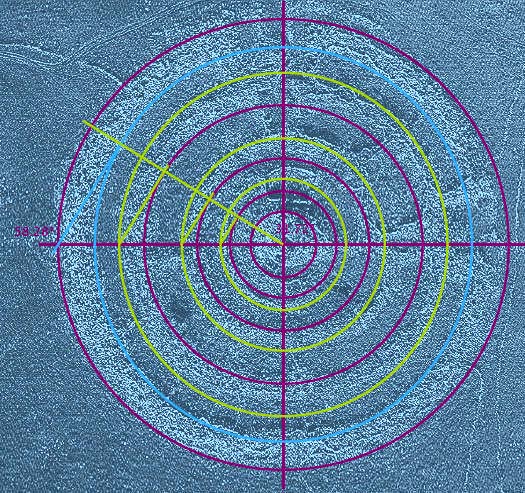
The radial width of each coil is one unit from wall to wall, and the diameters of the central field are one unit in the example at left, two units in the middle one, and five units in the one at right. The thin dashed lines in the circuits above represent the path through each labyrinth, and the thick solid lines represent the "walls" between the coils of its path. These three possible versions are shown below, with their fields numbered along the path of a classical labyrinth: No other center size permits this arrangement. There are three possible configurations for arranging 60 equally wide fields in three rings around a center, one each for centers which are either as wide as the path, or twice its width, or five times. The Senet path is folded flat with its two U-turns between three parallel rows whereas the round shape of the Disk suggests that the two U-turns in its reunited path folded its circuits into three concentric wraps. Preserving both these U-turns in the proposed reconstruction of the original path highlights yet another si milarity between the game on the Disk and its Egyptian sibling Senet which had also two U-turns in its path. The labyrinth associated with Crete in Classical times typically had seven circuits instead of the three derived from the Disk, but board games are always simplified simulations of what they represent, and this one is no exception. No one has ever found that famous structure of Minotaur fame, but it played a prominent role in Crete's mythological past. This labyrinth shape may be no accident because the Disk was dug up on Crete, an island renowned for its legendary labyrinth. We get a more elegant design and a smoother transition from one ring to the next if we preserve both the U-turns from the combined path on the Disk, each one located after the completion of a loop for a clean transition to the next.įolding the Disk path in this wrap-and-turn fashion produces the mini-labyrinths with three circuits shown below. However, a single U-turn on a board with three loops in its path makes the layout unbalanced. The U-turns in the paths on each side of the Disk evoke the direction-reversing paths on the traditional race games on square boards in India, as discussed in chapter 2.3.2. It seems therefore likely that the fields on this postulated original board were of mostly equal length along its path, as was and still is customary for most other game boards. This is confirmed by the several pictures of normally horizontal items, such as the ship and the "night sky", that the Disk maker turned vertical to save space. They only use the space needed to note the signs in each field. Therefore, the field sizes on this small clay notepad for the larger gameboard track don’t necessarily reflect those on the original which it copied. The maker of this memory aid condensed the layout to the minimum required for all the stamps and used both sides of the clay surface to save space and weight for easy portability.

#Rogem hiri portable#
The irregular lengths of the fields on the Disk support the argument that the Disk was only a notepad to record in a compact and portable form the signs from the fields on an originally combined gameboard, as proposed in chapter 2.4. However, whereas the 61 fields on the Disk are of different lengths to fit the different numbers and sizes of signs in each, the 60 fields surrounding the center on the actual gameboard were more likely of equal size, as they usually are on virtually all known ancient and modern gameboards. To restore the recombined path from both sides of the Phaistos Disk, the most obvious approach is to follow the present layout on each Disk side, with three concentric rings around a center, and to incorporate into these the two U-turns from both sides that are a part of this path. Reconstructing the original layout of the gameboard path Solomon's Sky : The Tapestry of Heaven from the Phaistos Diskĩ.1.


 0 kommentar(er)
0 kommentar(er)
